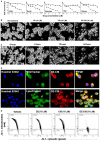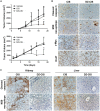Targeting Burkitt lymphoma with a tumor cell-specific heptamethine carbocyanine-cisplatin conjugate
- PMID: 30840322
- PMCID: PMC6618854
- DOI: 10.1002/cncr.32033
Targeting Burkitt lymphoma with a tumor cell-specific heptamethine carbocyanine-cisplatin conjugate
Abstract
Background: Burkitt lymphoma is a fast-growing mature B cell malignancy, whose genetic hallmark is translocation and activation of the c-myc gene. Prompt multiagent immunochemotherapy regimens can have favorable outcomes, but prognosis is poor in refractory or relapsed disease. We previously identified a novel family of near-infrared heptamethine carbocyanine fluorescent dyes (HMCD or DZ) with tumor-homing properties via organic anion-transporting peptides. These membrane carriers have uptake in tumor cells but not normal cells in cell culture, mouse and dog tumor models, patient-derived xenografts, and perfused kidney cancers in human patients.
Methods: Here we report the cytotoxic effects of a synthesized conjugate of DZ with cisplatin (CIS) on B cell lymphoma CA46, Daudi, Namalwa, Raji, and Ramos cell lines in cell culture and in xenograft tumor formation. Impaired mitochondrial membrane permeability was examined as the mechanism of DZ-CIS-induced lymphoma cell death.
Results: The new conjugate, DZ-CIS, is cytotoxic against Burkitt lymphoma cell lines and tumor models. DZ-CIS retains tumor-homing properties to mitochondrial and lysosomal compartments, does not accumulate in normal cells and tissues, and has no nephrotoxicity in mice. DZ-CIS accumulated in Burkitt lymphoma cells and tumors induces apoptosis and retards tumor cell growth in culture and xenograft tumor growth in mice.
Conclusion: DZ-CIS downregulated c-myc and overcame CIS resistance in myc-driven TP53-mutated aggressive B cell Burkitt lymphoma. We propose that DZ-CIS could be used to treat relapsed/refractory aggressive Burkitt lymphomas.
Keywords: Burkitt lymphoma; cell death; cisplatin; conjugate; heptamethine carbocyanine.
© 2019 The Authors. Cancer published by Wiley Periodicals, Inc. on behalf of American Cancer Society.
Conflict of interest statement
DZ‐CIS is licensed to DaZen Theranostics, Inc., where Leland W. K. Chung is currently serving as the Chairman of the Board and Chief Scientist for the development of one of the licensed lead compounds from laboratory to the clinic and for which Stefan Mrdenovic, Yi Zhang, Ruoxiang Wang, and Gina Chia‐Yi Chu are shareholders. Leland W. K. Chung also has a patent pending (US 2016/0310604 A1).
Figures





Similar articles
-
A cisplatin conjugate with tumor cell specificity exhibits antitumor effects in renal cancer models.BMC Cancer. 2023 Jun 2;23(1):499. doi: 10.1186/s12885-023-10878-3. BMC Cancer. 2023. PMID: 37268911 Free PMC article.
-
Triptolide induces mitochondria-mediated apoptosis of Burkitt's lymphoma cell via deacetylation of GSK-3β by increased SIRT3 expression.Toxicol Appl Pharmacol. 2018 Mar 1;342:1-13. doi: 10.1016/j.taap.2018.01.011. Epub 2018 Feb 4. Toxicol Appl Pharmacol. 2018. PMID: 29407771
-
MDM4 Is Targeted by 1q Gain and Drives Disease in Burkitt Lymphoma.Cancer Res. 2019 Jun 15;79(12):3125-3138. doi: 10.1158/0008-5472.CAN-18-3438. Epub 2019 Apr 18. Cancer Res. 2019. PMID: 31000522
-
Heptamethine Cyanine Dye Mediated Drug Delivery: Hype or Hope.Bioconjug Chem. 2020 Jul 15;31(7):1724-1739. doi: 10.1021/acs.bioconjchem.0c00302. Epub 2020 Jun 24. Bioconjug Chem. 2020. PMID: 32530288 Review.
-
Targeted therapy in Burkitt lymphoma: Small molecule inhibitors under investigation.Br J Haematol. 2024 Jun;204(6):2165-2172. doi: 10.1111/bjh.19425. Epub 2024 Apr 5. Br J Haematol. 2024. PMID: 38577716 Review.
Cited by
-
Breast Cancer MCF-7 Cells Acquire Heterogeneity during Successive Co-Culture with Hematopoietic and Bone Marrow-Derived Mesenchymal Stem/Stromal Cells.Cells. 2022 Nov 10;11(22):3553. doi: 10.3390/cells11223553. Cells. 2022. PMID: 36428982 Free PMC article.
-
Novel Mitochondria-Based Targeting Restores Responsiveness in Therapeutically Resistant Human Lung Cancer Cells.Mol Cancer Ther. 2021 Dec;20(12):2527-2538. doi: 10.1158/1535-7163.MCT-20-1095. Epub 2021 Sep 28. Mol Cancer Ther. 2021. PMID: 34583981 Free PMC article.
-
A heptamethine cyanine dye serves as a potential marker for myeloid-derived suppressor cells.Am J Cancer Res. 2021 Jun 15;11(6):2853-2866. eCollection 2021. Am J Cancer Res. 2021. PMID: 34249432 Free PMC article.
-
Intraoperative assessment and postsurgical treatment of prostate cancer tumors using tumor-targeted nanoprobes.Nanotheranostics. 2021 Jan 1;5(1):57-72. doi: 10.7150/ntno.50095. eCollection 2021. Nanotheranostics. 2021. PMID: 33391975 Free PMC article.
-
Novel DZ-SIM Conjugate Targets Cancer Mitochondria and Prolongs Survival in Pancreatic Ductal Adenocarcinoma.Adv Ther (Weinh). 2022 Oct;5(10):2200021. doi: 10.1002/adtp.202200021. Epub 2022 Jul 19. Adv Ther (Weinh). 2022. PMID: 36590644 Free PMC article.
References
-
- Molyneux EM, Rochford R, Griffin B, et al. Burkitt’s lymphoma. Lancet. 2012;379:1234‐1244. - PubMed
-
- Swerdlow SH, Campo E, Harris NL, et al. WHO classification of tumors of haematopoietic and lymphoid tissues, Revised Fourth Edition. Geneva, Switzerland: World Health Organization; 2017.
-
- Brown JR, Freedman AS, Aster JC. Pathobiology of Burkitt lymphoma. UpToDate. https://www.uptodate.com/contents/pathobiology-of-burkitt-lymphoma. Accessed July 1, 2018.
-
- ar‐Rushdi A, Nishikura K, Erikson J, Watt R, Rovera G, Croce CM. Differential expression of the translocated and the untranslocated c‐myc oncogene in Burkitt lymphoma. Science. 1983;222:390‐393. - PubMed
Publication types
MeSH terms
Substances
LinkOut - more resources
Full Text Sources
Research Materials
Miscellaneous

